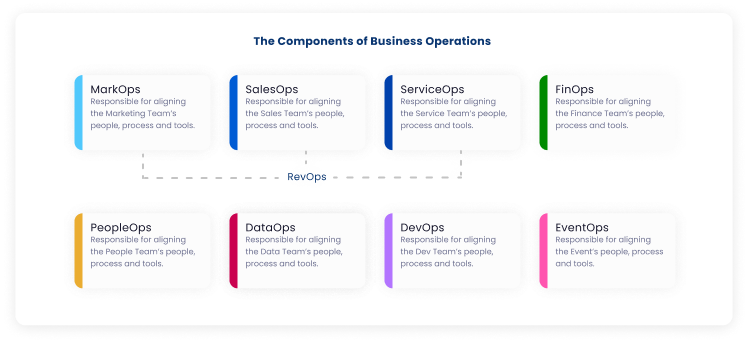Get started today.
Design & improve how your processes and systems work
Use Puzzle to see how your business runs today, map how it should work tomorrow, and quantify the value of innovation—before you make the change.

Your organization has a way of working — leads are generated, emails are sent, meetings are held, deals are closed, projects started and completed, widgets manufactured and shipped, invoices sent and paid — but how exactly does all the work happen?
Enter: Business Operations — the way work gets done.
Business Operations is the work of creating and managing the internal processes and tools that unify team members and assets in an efficient way to produce outcomes for your organization.
It is the intersection of performance, people, processes, and tools. The specifics of your business operations depend on your industry, your products and services, the stage of your business, and how you choose to build your systems and tools.

Business operations is a layered system of people, process, and tools.
Organizations with undefined business operations commonly suffer from these pain points:
You have no reliable way to monitor the performance and capacity of teams
You produce inconsistent results and break promises to stakeholders
Your team is misaligned on who is responsible for what internally
Your team miscommunicates and has no accountability
Your tasks are all manual and require a lot of human hours to do
Your data structures are different across all of your tools and systems
You rely on shadow training, doubling the costs of each onboarding
There is no inter-departmental empathy for departmental challenges
Organizations that have invested in their business operations benefit in various ways:
Adapt your process according to market needs or changes
Produce consistent results to earn customer loyalty
Automate recurring tasks to get time back in your workweek
Integrate tools and systems to increase your data accuracy
Maximize your technology stack’s return on investment
Reliably measure team member’s performance based on outcomes
Easily train new external hires, or help bolster bottom performers
Maximize your team’s skillset across the organization
Ultimately business operations is all about introducing efficiency, productivity, consistency, and transparency in how work gets done across the organization. To understand how these outcomes are achieved, let’s break down the components of Business Operations.
No business is built the same, but most share these components of their business operations:
All these components are intertwined in a complex system of constantly moving parts across your organization. It’s built from multiple functions that need to work together, which is why business operations teams often work across the organization. But sometimes, the BizOps team is not centralized. Instead, there are smaller dedicated teams responsible for the same set of components mentioned above specifically for their team or department:
MarkOps —responsible for enabling the Marketing team’s operations; responsibilities include ensuring accurate campaign attribution, managing ad budget, implementing marketing technology stack: Content Management System (CMS), Email Marketing, Customer Analytics, and Chatbot tools.
SalesOps — responsible for enabling the Sales team’s operations; responsibilities include ensuring proper lead routing and lead scoring logic, building high-performing sequences, implementing sales technology stack: Customer Relationship Management (CRM), eSignature, Document Tracking tools.
ServiceOps — responsible for enabling Customer Success, Support, Delivery, or Experience teams’ operations; responsibilities include developing a customer onboarding process, managing knowledge base, enabling agents to maintain service-level agreements (SLAs), and implementing service technology stack: Project Management (PM), Ticket Management System, Time Tracking, and Survey tools.
RevOps — the combination of MarkOps, SalesOps, and ServiceOps; the definition combines all the Business Operations related to generating revenue.
FinOps — responsible for turning business transactions into financial transactions; responsibilities include sales commission tracking, expense reporting, subscription management, invoice management, payment processing, sales tax management, cap table management, and implementing a finance technology stack that supports these functions.
PeopleOps — responsible for enabling Human Resources team’s operations; responsibilities include attracting and hiring top talent, increasing employee productivity through development, engagement, and retention, and implementing a technology stack: Applicant Tracking System, Goal Tracking, Performance Reviews, and Employee Survey tools.
DataOps — responsible for enabling the flow and access to data across the organization’s operations; responsibilities include setting up data infrastructure, improving the transparency, quality, and the cycle time of data analytics, operationalizing data to non-technical teams, and implementing data stack: Data Integration, Data warehouse, Data Transformation & modeling, and Business Intelligence platforms.
DevOps — responsible for enabling engineers to deliver applications and services at a high velocity; responsibilities include finding. ways to increase the pace of releases, ensure the reliability of application updates, and manage development, testing, and production environments.
EventOps — responsible for enabling guests on-site at a company event; responsibilities include transportation arrangement, agenda management, on-site registrations, managing vendor services, setting up technical production, supporting guests, and implementing technologies that help orchestrate these functions.

These teams work together to bring efficiencies in rapidly scaling organizations through improving processes to maximize outcomes and building organizational capacity. They must up-level everything they touch such that things work better and faster after they are no longer involved. It is challenging work, but a set of best practices makes the process of making the process enjoyable! The goal is to go from firefighting to working with the big picture in mind.

Use Puzzle to see how your business runs today, map how it should work tomorrow, and quantify the value of innovation—before you make the change.